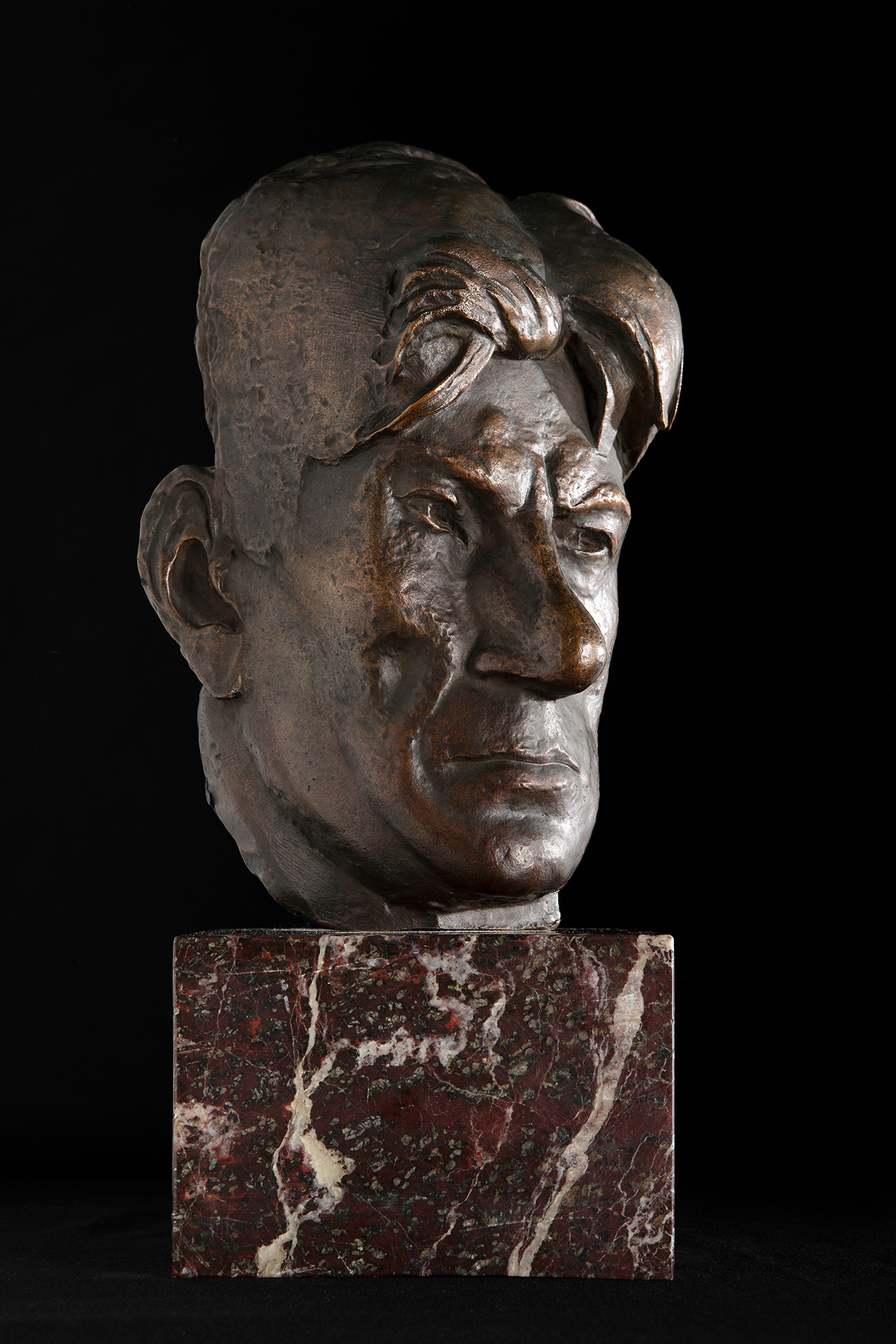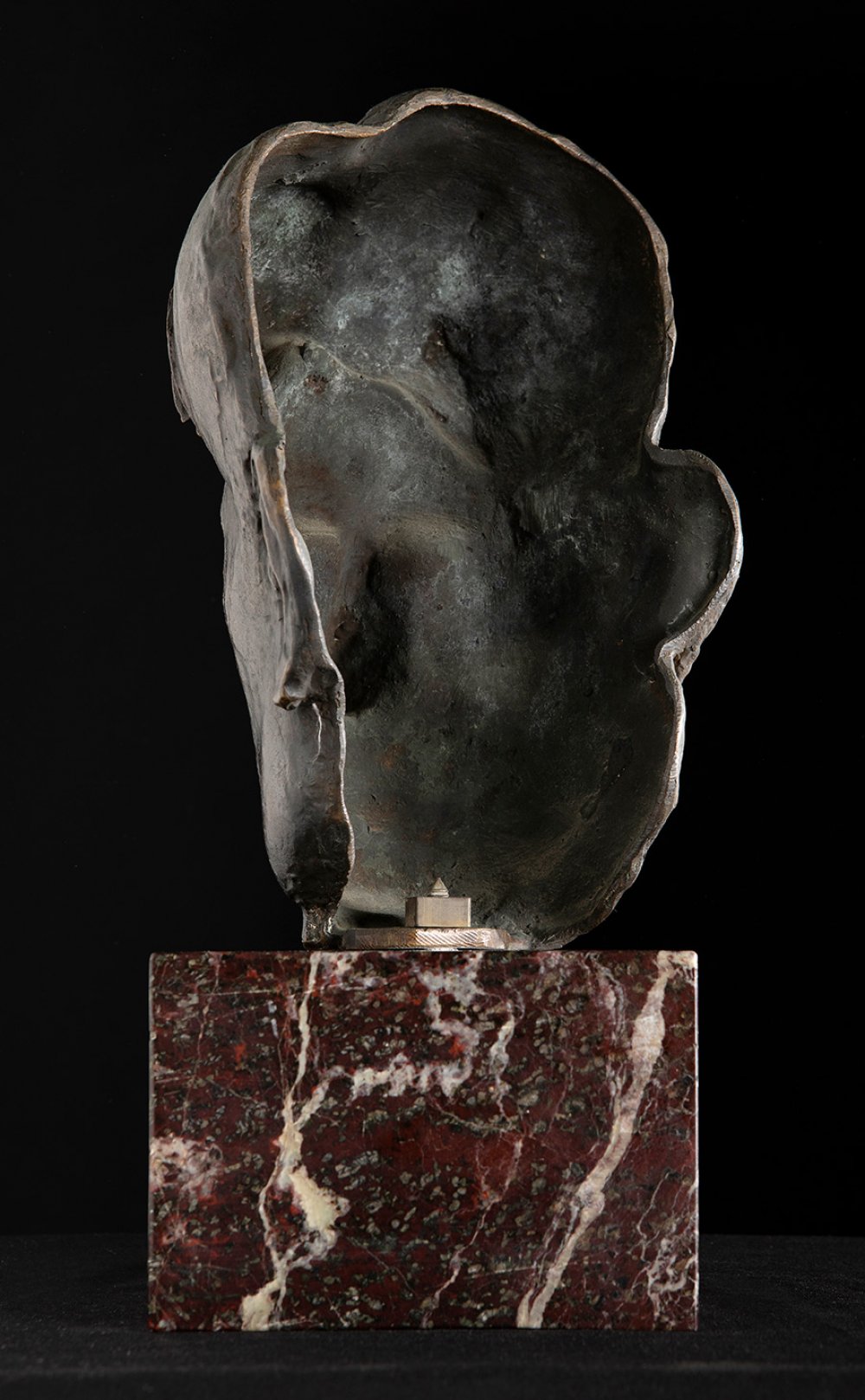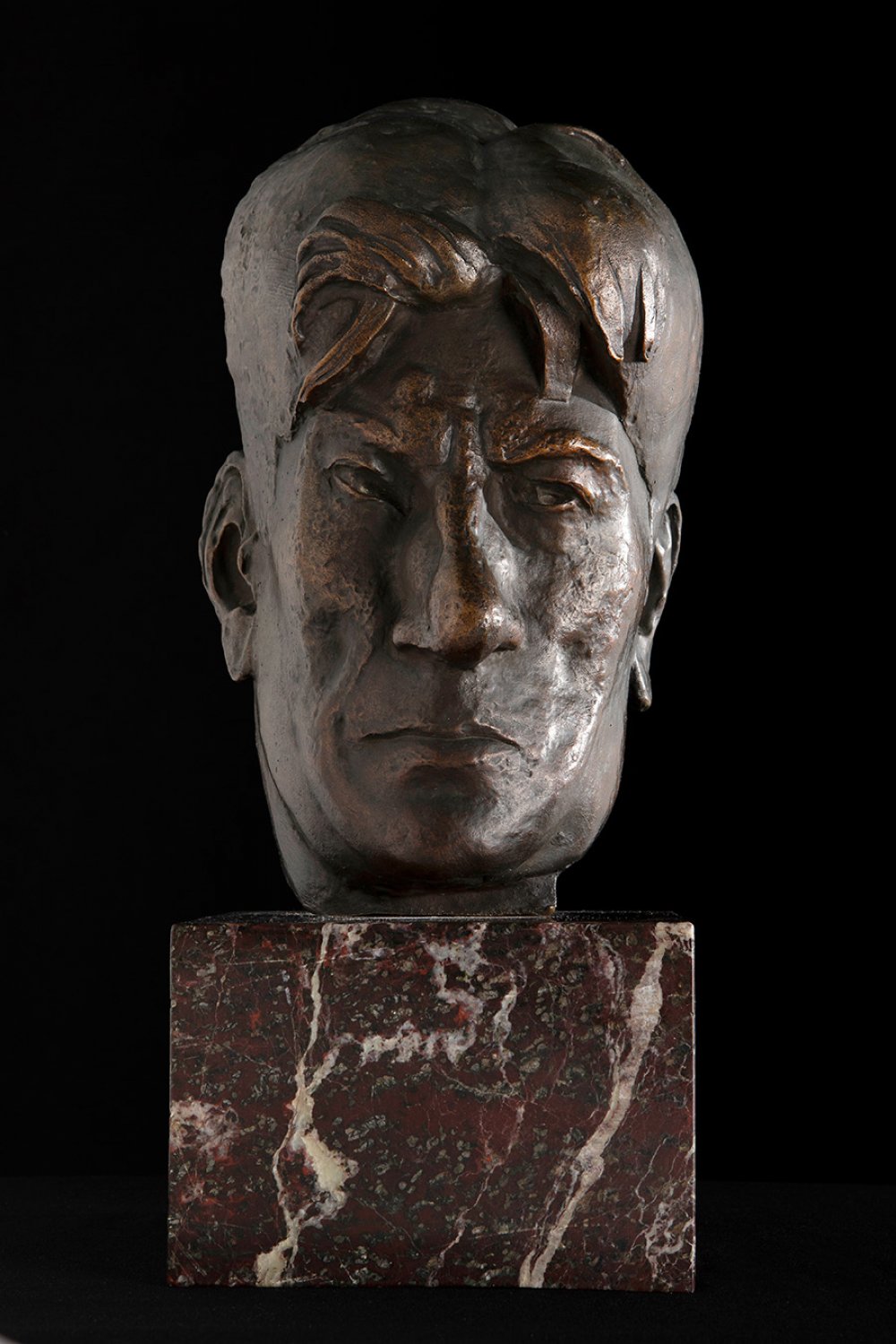25
MANOLO HUGUÉ (Barcelona, 1872 - Caldas de Montbui, Barcelona, 1945)."Violinist Costa", ca.1941.
"Violinist Costa", ca.1941.
Bronze.
Marble base.
A clay copy of this work is catalogued in: Montserrat Blanch, "Manolo", Barcelona, Polígrafa, 1972, p. 120, nº215.
Measurements: 30 x 17 x 16 cm. (bronze); 10.5 x 16 x 16 x 16 cm.(base).
One of the aspects that Montserrat Blanch, art historian and specialist in the work of Manolo Hugué, highlights as defining the period in which the sculptor lived in Caldes de Montbui (1927-1945) is his attention to the portrait genre. Of the Violinist Costa produced a full-length bronze, but also a portrait (first in clay, then in bronze) focusing only on the head, and therefore on pure expression. The process of making this sculpture is, following his characteristic archaic approach, to take as a starting point a basic volume, which was taking shape from the inside, animated by the simple insertion of life and truth in it: avoiding details, he concentrates in his spirit the essence of his idea of the portrayed, which, in the end, emerges with full freshness. Subtly exaggerating the physical features, he delves into the character, achieving a volumetric form that is a repository of emotional energy.
Manuel Martínez Hugué, Manolo Hugué, trained at the Escuela de la Lonja in Barcelona. A regular participant in the gatherings at Els Quatre Gats, he became friends with Picasso, Rusiñol, Mir and Nonell. In 1900 he moved to Paris, where he lived for ten years. There he resumed his relationship with Picasso, and became friends with other avant-garde theoreticians such as Apollinaire, Modigliani, Braque and Derain. In the French capital he worked on the design of jewellery and small sculptures, influenced by the work of his friend, the sculptor and goldsmith Paco Durrio. In 1892 he worked with Torcuato Tasso on decorative works for the celebrations of the centenary of the Discovery of America. Between 1910 and 1917, devoted entirely to sculpture, he worked in Ceret, where he brought together a heterogeneous group of artists including Juan Gris, Joaquín Sunyer and, once again, Picasso. During these years he held exhibitions in Barcelona, Paris and New York. In 1932 he was appointed a member of the Royal Academy of Fine Arts of San Jorge in Barcelona. In Hugué's work, what is essential is the relationship with nature, taking into account the human figure as an integrated element in it. This is a characteristic of Noucentista classicism, but in Hugué's hands it goes beyond its limited origins. He usually depicted peasants, although he also depicted bullfighters and dancers - as can be seen on this occasion - always portrayed with a level of detail and an appreciation of textures that reveal his early training as a goldsmith. In his artistic production, Mediterranean tradition, Greek classicism and archaism, and the art of ancient Egypt and Mesopotamia coexist with the European avant-garde, which he assimilated and knew first-hand, specifically Matisse's Fauvism and Cubism. Works by Hugué are kept in the MACBA, the Georges Pompidou Centre in Paris, the Museo Nacional de Arte de Cataluña and the Museo Nacional Centro de Arte Reina Sofía, among many others.
"Violinist Costa", ca.1941.
Bronze.
Marble base.
A clay copy of this work is catalogued in: Montserrat Blanch, "Manolo", Barcelona, Polígrafa, 1972, p. 120, nº215.
Measurements: 30 x 17 x 16 cm. (bronze); 10.5 x 16 x 16 x 16 cm.(base).
One of the aspects that Montserrat Blanch, art historian and specialist in the work of Manolo Hugué, highlights as defining the period in which the sculptor lived in Caldes de Montbui (1927-1945) is his attention to the portrait genre. Of the Violinist Costa produced a full-length bronze, but also a portrait (first in clay, then in bronze) focusing only on the head, and therefore on pure expression. The process of making this sculpture is, following his characteristic archaic approach, to take as a starting point a basic volume, which was taking shape from the inside, animated by the simple insertion of life and truth in it: avoiding details, he concentrates in his spirit the essence of his idea of the portrayed, which, in the end, emerges with full freshness. Subtly exaggerating the physical features, he delves into the character, achieving a volumetric form that is a repository of emotional energy.
Manuel Martínez Hugué, Manolo Hugué, trained at the Escuela de la Lonja in Barcelona. A regular participant in the gatherings at Els Quatre Gats, he became friends with Picasso, Rusiñol, Mir and Nonell. In 1900 he moved to Paris, where he lived for ten years. There he resumed his relationship with Picasso, and became friends with other avant-garde theoreticians such as Apollinaire, Modigliani, Braque and Derain. In the French capital he worked on the design of jewellery and small sculptures, influenced by the work of his friend, the sculptor and goldsmith Paco Durrio. In 1892 he worked with Torcuato Tasso on decorative works for the celebrations of the centenary of the Discovery of America. Between 1910 and 1917, devoted entirely to sculpture, he worked in Ceret, where he brought together a heterogeneous group of artists including Juan Gris, Joaquín Sunyer and, once again, Picasso. During these years he held exhibitions in Barcelona, Paris and New York. In 1932 he was appointed a member of the Royal Academy of Fine Arts of San Jorge in Barcelona. In Hugué's work, what is essential is the relationship with nature, taking into account the human figure as an integrated element in it. This is a characteristic of Noucentista classicism, but in Hugué's hands it goes beyond its limited origins. He usually depicted peasants, although he also depicted bullfighters and dancers - as can be seen on this occasion - always portrayed with a level of detail and an appreciation of textures that reveal his early training as a goldsmith. In his artistic production, Mediterranean tradition, Greek classicism and archaism, and the art of ancient Egypt and Mesopotamia coexist with the European avant-garde, which he assimilated and knew first-hand, specifically Matisse's Fauvism and Cubism. Works by Hugué are kept in the MACBA, the Georges Pompidou Centre in Paris, the Museo Nacional de Arte de Cataluña and the Museo Nacional Centro de Arte Reina Sofía, among many others.
19th October - 19th & 20th Century Art
Sale Date(s)
Venue Address
General delivery information available from the auctioneer
Setdart offers Worldwide shipping
PICK UP IN ROOM: You can come and pick up your lots in our offices (Barcelona, Madrid or Valencia). At the moment of the withdrawal, you will be able to accept the current conditions of the lot by means of a document that you will sign.
YOU CAN SEND ANOTHER PERSON TO PICK UP: This person must present a signed authorization that you can find in our web page by accessing from BUY AT SETDART- LOGISTICS-DOWNLOAD AUTHORIZATION DOCUMENT. You can also send an e-mail with the requested data in AUTHORIZATION DOCUMENT to admin@setdart.com
Important Information
25% buyer´s premium
21% buyer´s premium at www.setdart.com
Terms & Conditions
The maximum period to pay the lots is 7 working days. You can pay either via bank transfer or with credit card through our platform www.setdart.com (we only accept VISA or Mastercard).
BUYER´S PREMIUM: 22% Hammer price + 21% VAT from the buyer´s premium
If your piece has more than 100 years, our Ministry of Culture requires an export certificate in order for the piece to leave the country. Note that if the piece goes inside the EU, there is no cost for the export certificate. If the piece goes outside the EU, there is a cost for the export certificate. You can find more information in our Ministry of Culture website: https://www.culturaydeporte.gob.es/en/cultura/patrimonio/exportacionimportacion/exportacion/tasas.html
INQUIRIES: admin@setdart.com
Setdart guides you through the entire process, from the time of award to the day you receive your lot. Our logistics team will be happy to manage your transport, and will advise you on the best shipping method with professionals from the sector used to handling works of art and jewelry.
WE OFFER WORLDWIDE DOOR TO DOOR SHIPPING
PICK UP IN ROOM: You can come and pick up your lots in our offices. At the moment of the withdrawal, you will be able to accept the current conditions of the lot by means of a document that you will sign.
YOU CAN SEND ANOTHER PERSON TO PICK UP: This person must present a signed authorization that you can find in our web page by accessing from BUY AT SETDART-LOGISTICS-DOWNLOAD AUTHORIZATION DOCUMENT. You can also send an e-mail with the requested data in AUTHORIZATION DOCUMENT to admin@setdart.com
SETDART IS NOT RESPONSIBLE FOR THE STATE OF THE PARTS ONCE THEY LEAVE OUR FACILITIES. MRW SHIPMENTS: Once the payment is made, your lot will be packed for shipment, the logistics department will send you an e-mail notifying you of the day it leaves our warehouse, changes of address cannot be made after receiving this e-mail.
INSURANCE INCIDENTS: Coverage for the value of the auction up to 3000 ? per shipment, if the value of the auction is higher, Setdart will send you a quote including the additional insurance. The insurance company WILL NOT BE RESPONSIBLE FOR THE SHIPMENT THAT EXCEEDS THAT AMOUNT AND IS NOT FULLY INSURED. MRW INCIDENTS: Maximum notification 48 hours after receipt, after which the insurance company WILL NOT BE RESPONSIBLE AND NO CLAIMS WILL BE ACCEPTED.
E-MAIL LOGISTICS: logistica@setdart.com
PICK UP YOUR MESSAGES: You can send your own messaging, prior notice via e-mail that your shipment is ready, please note 3 or 4 days in advance. This type of shipment is packaged so Setdart will provide you with a quote.
EXPENSES FOR STORAGE: We inform you that if the purchased lot is not picked up within a month, you will be charged 30€ per week per lot. Setdart Online S.L., owner of the web site "setdart.com", "setdart.net" and "setdart.org", acts as a company of Spanish nationality inscribed in the Volume 36955, sheet 182, page B-293056 of the Mercantile Registry, with registered office at Calle Aragó









